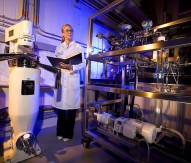
Study examines evolution of components of spent nuclear fuel
A study co-authored by the Joint Research Centre (JRC) has examined the evolution of components of spent nuclear fuel by comparing actual spent fuel with lab results obtained on fuel equivalents in a simulated accelerated timescale.
Most of the trends observed were found to be comparable with characteristics of actual spent fuel. Such comparisons help make safety assessments of the alterations that occur in conditions of prolonged storage of spent fuel, while waiting for its final disposal in a geological repository. The most common types of spent nuclear fuel – irradiated uranium dioxide (UO2) and uranium-plutonium mixed oxide fuel – were examined.
JRC scientists gathered a large set of experimental data to study the effects of accumulated alpha-decay damage and helium in UO2 at different scales, from a microstructural level (the accumulation of crystal defects, helium bubbles formation, and lattice parameter swelling) up to macroscopic property changes such as hardening and thermal conductivity degradation. In order to reproduce cumulative effects expected during relatively long storage times within acceptable laboratory timescales, accelerated damage build-up conditions were applied by using unirradiated mixed uranium-plutonium oxides with high specific alpha-activity.
The outcome of the experiments showed a non-negligible extent of lattice swelling, which refers to the physical dimensions of the crystal structure in the UO2 fuel matrix. If the microstructural lattice swelling results in macroscopic swelling of the fuel pellets in spent fuel rods, additional stresses could be applied on the metallic cladding containing the fuel, which may then be a safety concern.
The study also pointed to the saturation of most macroscopic property changes – meaning a stabilised condition with no further alterations – for a simulated timescale corresponding to spent fuel after decades or centuries of storage (the exact time scale depends on parameters like fuel composition and burnup).
The retention of the mechanical integrity of spent nuclear fuel rods during and after storage is affected by the radioactive decay process. Other mechanisms that may cause property degradation are related to the temperature history experienced by the spent rods, and are determined by the behaviour of hydrogen present in the cladding. Results obtained under accelerated conditions must be compared to the properties of actual spent nuclear fuel in order to define the applicability of short term lab scale experimental data to the prediction of potential spent fuel rod alterations over many decades or centuries as a function of storage conditions.
On-going programmes also address the retrievability of spent fuel after extended storage and its behaviour under accident conditions.





